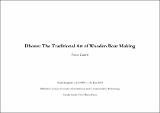| dc.description.abstract | Boat building forms a very important part of the economy along the coast of Gujarat. Salaya, Veraval and Mandvi are towns of fishermen, boat makers and traders. In these regions boat building is an integral part of their daily lives. There is a unique relationship between traders, boat makers and fishermen. Traders invest, boat makers build the Dhows and fishermen use them. Dhows are a central aspect both socio-economically and culturally in the port towns of Gujarat. Every individual is directly or indirectly connected to the boat makers, repairers, helpers and carpenters. Some members of the community are engaged in the transportation of timber, fishing, and net making or in the supply of timber. Some members are associated with the fisheries industry. There are others who are engaged in recycling wood to build bridges or doors and in selling wood from broken down ships.
Dhow builders neither require a large industrial set up nor hundreds of people but the methodology and precision with which these craftsmen operate is comparable to any large industry with huge investments. Most of the traditional boats are built in temporary yards with sheds that are erected by carpenters, on land at the port, rented to them by the Government.
The ports are busy places with the sound of carpenters at work. Dhows stand tall on the coastal wetland, the deck swarms with carpenters, labourers and errand boys going about their work. It takes an average of six months for a Dhow to take shape with ten to twelve
carpenters working continuously.
Carpenters arrive purposefully at the site at 9am and work till dusk making full use of daylight hours. They are adept at handling wood almost like clay or paper, curving and bending wood to get the desired shape. It is pleasurable experience to see how they create Dhows from a single plank of wood that could have a load carrying capacity ranging from five hundred to fifteen hundred tonnes and keep sailing for about thirty years. A well-built Dhow could last for fifty years if well maintained.
All year round at the port there are several boats at various stages of construction. During monsoons when the fleets return from sea repair work increases and waters are crammed with Dhows under repair and streets are abuzz with sailors. Dhows are pulled up on spare ground, allowed to dry, repaired, oiled and set afloat again. During the four months of monsoons Indian Government bans any vehicle from going into the sea as waters are too dangerous and rough. Near every Dhow there is a modest shack made with wood waste and gunny bags where the watchman lives. A small cabin built with recycled planks serves as a
shelter from the scorching sun and a place to relax for the contractor and other workers. Small Paan cabins and tea stalls serve as addas for the workers, primarily for conversation and playing cards.
Buzz word ‘sustainability’ finds its true meaning in these clusters where still their system of making and living has been well integrated. It examines how people, places and things are constituted through every day work practices and all the other relational, embodied, habitual
activities of life.
The wooden ship-building industry should get a boost as there is much potential. There were some plans to encourage Vahanvatti a few years ago but nothing came out of it. Government doesn’t provide any subsidies or benefits to the boat making community. | |

